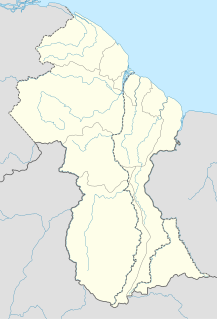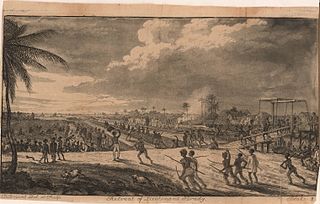| Total population | |
|---|---|
| 29.3% of Guyana's population (2012) | |
| Regions with significant populations | |
| Guyana (Georgetown, Linden, Essequibo Coast and New Amsterdam) United Kingdom, Canada, United States | |
| Languages | |
| English, Guyanese Creole, Dutch | |
| Religion | |
| Majority: Christianity Minority: Islam, Rastafari, Comfa, Afro-American religions, Traditional African religions |
Afro-Guyanese people are generally descended from the enslaved people brought to Guyana from the coast of West Africa to work on sugar plantations during the era of the Atlantic slave trade. Coming from a wide array of backgrounds and enduring conditions that severely constrained their ability to preserve their respective cultural traditions contributed to the adoption of Christianity and the values of British colonists. [1]
The Dutch West India Company turned to the importation of African slaves, who rapidly became a key element in the colonial economy. [2] By the 1660s, the slave population numbered about 2,500; the number of indigenous people was estimated at 50,000, most of whom had retreated into the vast hinterland. [2] Although African slaves were considered an essential element of the colonial economy, their working conditions were brutal. [2] The mortality rate was high, and the dismal conditions led to more than half a dozen slave rebellions. [2]
The most famous slave uprising, the Berbice Slave Uprising, began in February 1763. [2] On two plantations on the Canje River in Berbice, slaves rebelled, taking control of the region. [2] As plantation after plantation fell to the slaves, the European population fled; eventually only half of the whites who had lived in the colony remained. [2] Led by Cuffy (now the national hero of Guyana), the African freedom fighters came to number about 3,000 and threatened European control over the Guianas. [2] The freedom fighters were defeated with the assistance of troops from neighboring French and British colonies and from Europe. [2]
Colonial life was changed radically by the demise of slavery. [3] Although the international slave trade was abolished in the British Empire in 1807, [3] slavery itself continued in the form of "apprentice-ship". [4] In what is known as the Demerara rebellion of 1823 10–13,000 slaves in Demerara-Essequibo rose up against their masters. [5] Although the rebellion was easily crushed, [5] the momentum for abolition remained, and by 1838 total emancipation had been effected. [3]
The system of apprentice-ship was established to create a buffer period for plantation owners; to keep former slaves as labor but providing payment.[ citation needed ]
Even though there was still a demand for plantation labor, the labor conditions were no better post-emancipation, so former slaves were less inclined to work in the plantation system, favoring self-reliance or skilled work.[ citation needed ] Some ex-slaves moved to towns and villages, feeling that field labor was degrading and inconsistent with freedom, but others pooled their resources to purchase the abandoned estates of their former masters and created village communities. [3] [4] Establishing small settlements provided the new Afro-Guyanese communities an opportunity to grow and sell food, an extension of a practice under which slaves had been allowed to keep the money that came from the sale of any surplus produce. [3] The emergence of an independent-minded Afro-Guyanese peasant class, however, threatened the planters' political power, inasmuch as the planters no longer held a near-monopoly on the colony's economic activity. [3]
Emancipation also resulted in the introduction of new ethnic and cultural groups into British Guiana, [3] such as Chinese and Portuguese indentured laborers, who upon completing their contracts, became competitors with the new Afro-Guyanese middle class.[ citation needed ] The largest group of indentured laborers came from India, and would later grow into a thriving and competitive class. Unlike future immigrant groups, former slaves were not granted land or passage to their home country, and this, in addition to other race-based treatment and favoritism, created tension among the ethnic groups. [6] [7]
By the early twentieth century, the majority of the urban population of the country was Afro-Guyanese. [8] Many Afro-Guyanese people living in villages had migrated to the towns in search of work. [8] Until the 1930s, Afro-Guyanese people, especially those of mixed descent, comprised the bulk of the non-white professional class. [8] During the 1930s, as Indo-Guyanese began to enter the middle class in large numbers, they began to compete with Afro-Guyanese for professional positions. [8]
Slavery had a devastating impact on family and social structure, as individual family member were bought and sold with little regard to kinship or relation. Marriage was not legally recognized for slaves, and even after emancipation, weddings and legal marriages were cost-prohibitive. Household compositions vary, and can be matriarchal or a nuclear family unit. [9]
Although the greatest numbers of Afro-Guyanese are Christian,[ citation needed ] there are also followers of obeah,[ citation needed ] a folk religion of African origin, which incorporates beliefs and practices of all the immigrant groups. [10]
Afro-Guyanese make up a significant portion of the public sector workforce. [11] Afro-Guyanese face challenges to private sector involvement, such as access to financing. [12] In politics, Afro-Guyanese make up a large portion of A Partnership for National Unity party voters. [13]
In 2017, a United Nations expert group determined that Afro-Guyanese face discrimination in law enforcement, employment, and education. [14]
The history of Guyana begins about 35,000 years ago with the arrival of humans coming from Eurasia. These migrants became the Carib and Arawak tribes, who met Alonso de Ojeda's first expedition from Spain in 1499 at the Essequibo River. In the ensuing colonial era, Guyana's government was defined by the successive policies of Spanish, French, Dutch, and British settlers.

Demerara is a historical region in the Guianas on the north coast of South America which is now part of the country of Guyana. It was a Dutch colony until 1815 and a county of British Guiana from 1838 to 1966. It was located about the lower courses of the Demerara River, and its main town was Georgetown.
The music of Guyana encompasses a range of musical styles and genres that draw from various influences including: Indian, Latino-Hispanic, European, African, Chinese, and Amerindian music. Popular Guyanese performers include: Terry Gajraj, Eddy Grant, Dave Martins & the Tradewinds, Aubrey Cummings, and Nicky Porter. The Guyana Music Festival has proven to be influential on the Guyana music scene.
A Portuguese Guyanese is a Guyanese whose ancestors came from Portugal or a Portuguese who has Guyanese citizenship.

Islam in Guyana is the third largest religion in the country after Christianity and Hinduism, respectively. According to the 2002 census, 7.3% of the country is Muslim. However, a Pew Research survey from 2010 estimates that 6.4% of the country is Muslim. Islam was first introduced to Guyana via slaves from West Africa, but was suppressed on plantations until Muslims of India were brought to the country as indentured labor.

Rosignol is a small village on the west bank of the Berbice River in Mahaica-Berbice, Guyana.
Guyanese literature covers works including novels, poetry, plays and others written by people born or strongly-affiliated with Guyana. Formerly British Guiana, British language and style has an enduring impact on the writings from Guyana, which are done in English language and utilizing Guyanese Creole. Emigration has contributed to a large body of work relating the Guyanese diaspora experience.
The Railways of Guyana comprised two public railways, the Demerara-Berbice Railway and the Demerara-Essequibo railway. There are also several industrial railways mainly for the bauxite industry. The Demerara-Berbice Railway is the oldest in South America. None of the railways are in operation in the 21st century.

The Berbice slave uprising was a slave revolt in Guyana that began on 23 February 1763 and lasted to December, with leaders including Coffy. It is seen as a major event in Guyana's anti-colonial struggles, and when Guyana became a republic in 1970 the state declared 23 February as a day to commemorate the start of the Berbice slave revolt.

Vreed en Hoop is a village at the mouth of the Demerara River on its left bank, in the Essequibo Islands-West Demerara region of Guyana, located at sea level. It is the location of the Regional Democratic Council office making it the administrative center for the region. There is also a police station, magistrate's court and post office.
Ryhaan Shah is an Indo-Guyanese writer born in Berbice, Guyana. She is active in Guyanese public life as the President of the Guyanese Indian Heritage Association (GIHA).

Guyana, officially the Co‑operative Republic of Guyana, is a country on the northern mainland of South America and the capital city is Georgetown. Guyana is bordered by the Atlantic Ocean to the north, Brazil to the south and southwest, Venezuela to the west, and Suriname to the east. With 215,000 square kilometres (83,000 sq mi), Guyana is the third-smallest sovereign state by area in mainland South America after Uruguay and Suriname; it is also the second-least populous sovereign state in South America after Suriname.

The people of Guyana, or Guyanese, come from a wide array of backgrounds and cultures including aboriginal Amerindians, and those who are descended from the slaves and contract workers who worked in the sugar industry of the Caribbean for various European interests, mostly of Indian or African origins. Demographics as of 2012 are East Indian 39.8%, African 30.1%, mixed race 19.9%, Amerindian 10.5%, other 0.5%.

Rockstone is a town on the right bank of the Essequibo River in the Upper Demerara-Berbice Region of Guyana, altitude 6 metres. Rockstone is approximately 26 km west of Linden and is linked by road.

The Demerara rebellion of 1823 was an uprising involving more than 10,000 enslaved people that took place in the colony of Demerara-Essequibo (Guyana). The rebellion, which began on August 18, 1823, and lasted for two days, was led by slaves with the highest status. In part they were reacting to poor treatment and a desire for freedom; in addition, there was a widespread, mistaken belief that Parliament had passed a law for emancipation, but it was being withheld by the colonial rulers. Instigated chiefly by Jack Gladstone, a slave at "Success" plantation, the rebellion also involved his father, Quamina, and other senior members of their church group. Its English pastor, John Smith, was implicated.

Quamina Gladstone, most often referred to simply as Quamina, was a Guyanese slave from Africa and father of Jack Gladstone. He and his son were involved in the Demerara rebellion of 1823, one of the largest slave revolts in the British colonies before slavery was abolished.

Fort Wellington is a village located in the Mahaica-Berbice region of Guyana, serving as its regional capital.

Goed Fortuin is a village located in the Essequibo Islands-West Demerara region of Guyana. The village started as a sugar plantation in the early 1800s.

Werk-en-rust, also Werken-Rust, is a ward in Georgetown, Guyana, located along the Demerara River that feeds into the Atlantic Ocean.